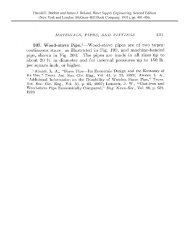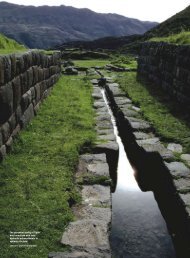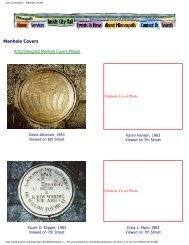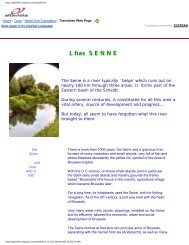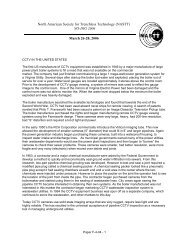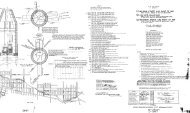The Water Supply and Distribution System of the Nabataean City of ...
The Water Supply and Distribution System of the Nabataean City of ...
The Water Supply and Distribution System of the Nabataean City of ...
Create successful ePaper yourself
Turn your PDF publications into a flip-book with our unique Google optimized e-Paper software.
Scaurus, an envoy <strong>of</strong> Pompey, sided with Nabataea’s<br />
enemies to defeat Aretas III in battle (64 BC). Rome<br />
declared <strong>the</strong> province <strong>of</strong> Syria under its control, <strong>and</strong><br />
<strong>Nabataean</strong>-controlled areas were subject to Roman<br />
invasions under Scaurus (62 BC) <strong>and</strong> Gabinius (55 BC).<br />
Despite <strong>the</strong> tumultuous political climate, <strong>Nabataean</strong><br />
political wisdom prevailed to maintain <strong>the</strong> establishment<br />
<strong>of</strong> an important trading empire with Petra as <strong>the</strong><br />
main administrative, commercial <strong>and</strong> religious centre.<br />
A series <strong>of</strong> <strong>Nabataean</strong> kings (Aretas I, c. 168 BC; Aretas<br />
II, 120/110–96 BC; Obodas I, 96–85 BC; Rabbel I, 85/84<br />
BC; Aretas III, 84–61 BC; Obodas II, 62–58 BC) presided<br />
over <strong>the</strong> expansion <strong>of</strong> commerce <strong>and</strong> urbanization<br />
at Petra, driving <strong>the</strong> city’s increasing water needs.<br />
<strong>Nabataean</strong> acquiescence in <strong>the</strong> inevitability <strong>of</strong> Roman<br />
dominance, <strong>and</strong> <strong>the</strong> commercial advantages <strong>of</strong> trade<br />
across territories consolidated under Roman rule,<br />
outweighed <strong>the</strong> advantages <strong>of</strong> autonomy. <strong>The</strong> city<br />
experienced Roman control under Tiberias, Caligua,<br />
Claudius, Vespasian <strong>and</strong> Hadrian, with administrative<br />
consolidation <strong>and</strong> territorial status change characterizing<br />
Roman dominance. Allied to Rome, <strong>Nabataean</strong>s,<br />
under King Malichus, were participants in suppressing<br />
<strong>the</strong> Jewish revolt in AD 67 (Josephus 1960). Rabbel<br />
II (AD 70) <strong>the</strong>n ushered in independence as a Roman<br />
ally that permitted Petra to continue its trade-based<br />
prosperity. Petra was formally annexed into <strong>the</strong> Roman<br />
Empire in AD 106 under Trajan. Throughout this<br />
period, caravan trade from Arabia, Africa <strong>and</strong> <strong>the</strong> East,<br />
with Petra as a key intersection node, sustained <strong>the</strong><br />
city’s wealth <strong>and</strong> supported <strong>the</strong> construction <strong>of</strong> commercial,<br />
ceremonial, administrative, manufacturing<br />
<strong>and</strong> water-supply structures commensurate with <strong>the</strong><br />
city’s wealth <strong>and</strong> status as an emporium city. Under<br />
Roman governance <strong>of</strong> Syria, <strong>the</strong> <strong>Nabataean</strong>s enjoyed<br />
relative independence, perhaps on account <strong>of</strong> tax <strong>and</strong><br />
tribute revenue to Rome. Wealth generated by trade<br />
<strong>and</strong> taxes on caravans to Cairo, Gaza, Damascus,<br />
Palmyra, Jauf, Median, Madain-Salih <strong>and</strong> Eastern<br />
locales, came finally under Roman dominance. <strong>The</strong><br />
gradual shift to sea trade (Taylor 2001) led to <strong>the</strong> decline<br />
<strong>of</strong> Petra’s status as an overl<strong>and</strong> trade centre, with<br />
Palmyra now replacing Petra for overl<strong>and</strong> caravan<br />
traffic from Silk Road destinations. Following Arab<br />
occupation after <strong>the</strong> collapse <strong>of</strong> <strong>the</strong> Byzantine Empire,<br />
<strong>the</strong> city faded from view until European rediscovery<br />
in <strong>the</strong> nineteenth century. Fur<strong>the</strong>r historical accounts<br />
(Taylor 2001; Guzzo & Schneider 2002; Gleuck 1959;<br />
1965; Hammond 1973; Levy 1999; Auge & Denzer<br />
2000; Bowersock 1983; Bourbon 1999; Browning<br />
1982) detail <strong>the</strong> many cultural <strong>and</strong> developmental<br />
influences <strong>the</strong> city experienced over many centuries<br />
<strong>of</strong> existence.<br />
Charles R. Ortl<strong>of</strong>f<br />
94<br />
Historical background <strong>of</strong> Petra’s watermanagement<br />
strategies<br />
It is clear that many exterior cultural, political <strong>and</strong><br />
technological influences colour <strong>the</strong> history <strong>of</strong> Petra.<br />
Consequently, <strong>the</strong> water-supply system may be<br />
expected to reflect borrowings from <strong>the</strong> best civil<br />
engineering practices <strong>of</strong> neighbouring civilizations<br />
<strong>and</strong> innovations derived from dem<strong>and</strong>s <strong>of</strong> <strong>the</strong> complex<br />
topography <strong>and</strong> limited water resource base <strong>of</strong><br />
<strong>the</strong> area. Innovations derived from direct experience<br />
<strong>of</strong> desert water-conservation measures are also to<br />
be expected given <strong>the</strong> nomadic background <strong>of</strong> <strong>the</strong><br />
<strong>Nabataean</strong>s. Egyptian, Mesopotamian, Minoan <strong>and</strong><br />
Greek civilizations all utilized piping systems for<br />
water supply <strong>and</strong> wastewater drainage. For example,<br />
<strong>the</strong> Temple at Knossos (Crete) at 2100 BC incorporated<br />
systems <strong>of</strong> conical, interlocking, terracotta piping<br />
elements in <strong>the</strong> main palace water system; later, <strong>the</strong><br />
Hellenic Temple <strong>of</strong> Artemis (Turkey) dating to 800 BC<br />
incorporated strings <strong>of</strong> socketed, mortared, terracotta<br />
pipes as well as lead-pipe segments joined by stone<br />
connectors to transport water from nearby springs.<br />
<strong>The</strong> Hanging Gardens <strong>of</strong> Babylon, during <strong>the</strong> reign<br />
<strong>of</strong> Nebuchadnezzar (605–562 BC), incorporated a highlevel<br />
reservoir from which water was delivered to<br />
terraces <strong>and</strong> fountains through hydrostatically pressurized<br />
terracotta pipelines. Egyptian copper <strong>and</strong> brass<br />
piping systems associated with 5th Dynasty Temples<br />
at Abusir form part <strong>of</strong> temple drainage systems to<br />
<strong>the</strong> Nile. A<strong>the</strong>ns in <strong>the</strong> 6–7th century BC <strong>and</strong> Olynthos<br />
had systems <strong>of</strong> interlocking terracotta pipes sealed<br />
by mortar, while <strong>the</strong> Ionian city <strong>of</strong> Priene (Turkey) in<br />
<strong>the</strong> third century BC had elaborate terracotta piping<br />
networks complete with filtration systems to purify<br />
water prior to distribution to city fountains (Ortl<strong>of</strong>f<br />
& Crouch 1998). In concept, many <strong>of</strong> <strong>the</strong>se systems<br />
are quite similar to those observed at Petra, indicating<br />
some use <strong>of</strong> previously-established technologies<br />
from surrounding societies. New learning gained<br />
through years <strong>of</strong> trade activity to many corners <strong>of</strong><br />
<strong>the</strong> ancient world would have provided yet fur<strong>the</strong>r<br />
sources <strong>of</strong> hydraulic knowledge. An early example<br />
<strong>of</strong> <strong>the</strong> <strong>Nabataean</strong> ability to learn from prior technologies<br />
is <strong>the</strong> 27-km-long Humeima canal from springs<br />
in <strong>the</strong> Sharma Mountains to a Wadi Rum outpost,<br />
attributed to Obadas I (96–86 BC) (Taylor 2001). This<br />
subterranean canal indicates that low-angle surveying<br />
technology was already understood — perhaps a<br />
borrowing from Greek <strong>and</strong> Roman geometric traditions<br />
(Cohen & Drabkin 1966; Lewis 2001). Combined<br />
with hydraulics knowledge from earlier sources this<br />
canal demonstrated it was possible to design a canal




